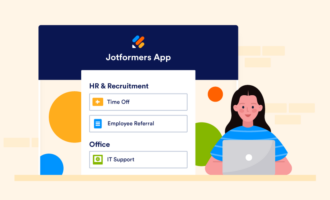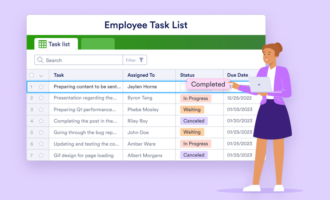How different types of collaboration work
- Open collaboration
- Closed collaboration
- Cross-functional collaboration
- Cross-cultural collaboration
- Document collaboration
- Virtual collaboration
We may have dreaded group projects in school, but there’s no denying that collaboration delivers a lot of benefits — especially in business. When teams work together, they’re more efficient and effective. But how do you foster a more collaborative culture at your organization?
There’s more than one way of getting there. In this post, we’ll break down the six most popular types of collaboration and how to choose the best kind of workplace collaboration for your organization. We’ll also share an ideal software solution to facilitate it.
How different types of collaboration work
1. Open collaboration
Broadly defined, open collaboration is entirely “open” to any and all new ideas or potential collaborators. It’s an approach in which everyone has an opportunity to contribute to a project.
Participants in an open collaboration setting have to leave all preconceived notions at the door about someone’s willingness or expertise to work on a project and, instead, let the chips fall where they may. With this approach, you may be pleasantly surprised by who shows up to collaborate and the invaluable ways they contribute to your project or team’s efforts.
For the most part, while open collaboration can and does work for different organizations, it works especially well for wide-ranging, large-scale projects that require a lot of input, such as a TEDx event or a company wiki.
2. Closed collaboration
As the name suggests, closed collaboration sets restrictions or boundaries on who can collaborate and what they can contribute. It’s typically best suited for companies that have strong partners and stakeholders already in place and know they can count on them to collaborate.
This isn’t to say that a closed collaboration can’t be as thought-provoking and generative as an open collaboration. In fact, the opposite is true. In a closed collaboration, because you focus on the knowledge you need to solve your problem, you can easily identify which key experts to involve. This is an excellent cost- and time-saving approach if your company or team lacks any of the necessary resources.
3. Cross-functional collaboration
The organizational structure of many businesses includes departments, units, and teams that largely work independently from one another. Cross-functional collaboration changes that dynamic and encourages collaboration from various departments and teams to work toward a common goal or project.
This is useful for streamlining sign-offs for big decisions on a project. Rather than going back and forth, the ongoing communication on a cross-functional team generates results quicker.
That said, cross-collaboration can pose some challenges if there’s no clear direction or scope for the project goal. Without a focused timeline or a clear end in sight, staff may put collaboration efforts on the backburner to focus on other responsibilities.
4. Cross-cultural collaboration
Cross-cultural collaboration is traditionally defined as collaboration that requires engaging with colleagues from around the globe. In some cases, this may include interacting with people in a country that has entirely different customs, languages, and traditions.
One of the most critical parts of cross-cultural collaboration is acknowledging, appreciating, and respecting different cultural perspectives as part of an effort to build positive and effective relationships. This kind of collaboration offers insightful perspectives and conversations, which is great if you’re trying to reach wider audiences.
Another important facet of cross-cultural collaboration is communication — and the software that facilitates it. Between different time zones, language barriers, and cultural norms, cross-cultural collaboration can be difficult to navigate, so clear and effective communication is essential. Even if everyone has to interact virtually, it will help diverse teams feel more connected and engaged.
5. Document collaboration
Document collaboration requires multiple authors to work on a single or multi-document project. One of the benefits of document collaboration is that you can get valuable peer-reviewed feedback, which adds credibility to the work.
But while multiple sets of eyes on a document can help identify areas of improvement, it also means navigating many opinions. That can be challenging, as everyone has an individual voice, style, background, and approach.
Other hurdles associated with this type of collaboration include ensuring access to the documents and preventing the creation of multiple versions.
6. Virtual collaboration
Virtual collaboration has no zip code — it transcends local, national, and even global barriers to bring all collaborators into a virtual workspace.
This requires technologies that make a virtual work environment possible, help organizations save on operating costs, and foster teamwork among employees who work remotely.
However, beware of potential fatigue. These days, nearly everyone regularly has a responsibility or an opportunity to engage in virtual spaces both personally and professionally, so this kind of collaboration can add to virtual burnout if we’re plugged in for too long.
How to choose the best type of workplace collaboration
Now that you know a bit more about some of the most popular types of collaboration, how do you choose the best approach for your organization?
It’s an ever-evolving process. The best type of workplace collaboration for your organization will likely change from project to project based on the specific scope of each, the size of the team, the project timeline, and where everyone is located.
Your organization might be a small team of 20 employees now, but if you expand to 100-plus employees and new locations in just a year or two, it will have an impact on how your team works together. With that in mind, you’ll need to reassess your approach regularly, but you can always combine various types of collaboration to meet your team’s needs.
Why Jotform Teams is the best solution for workplace collaboration
No matter which types of collaboration you ultimately decide to use for your organization or project, you need software to tie it all together. The right platform, like shared online workspace Jotform Teams, allows collaborators to create forms and reports, connect virtually, share data and documents, and assign roles and responsibilities — all in one safe, secure, centralized location.
With Jotform Teams, you can
- Instantly access up-to-date information, data, and resources
- Automate approval workflows to reduce backlogs and streamline processes
- Create folders to organize your projects by program, client, or department
- Generate data-driven, insightful reports
- Build an app without doing any coding to stay connected on the go
- Sign, share, and store documents
- Create multiple online workspaces for multiple teams
- Track and manage form submissions
Jotform Teams is powerful, easy to use, fully customizable, and completely code free — helping collaborators of all technical backgrounds work together and stay in control of their data.
Though workplace collaboration has its challenges, it also boasts significant rewards. These six types of collaboration, especially when coupled with software like Jotform Teams, can help your employees learn from each other, challenge themselves, and complete projects in a fun, engaging way.
Photo by Proxyclick Visitor Management System on Unsplash

























Send Comment: